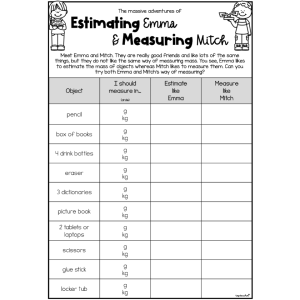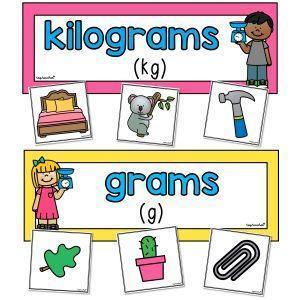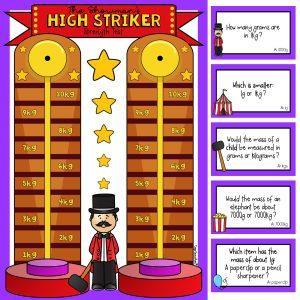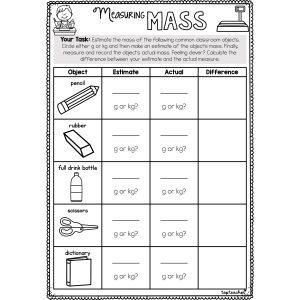Reading a Scale Worksheet

Description
The Reading a Scale Worksheet is a practical and engaging resource designed to support students as they develop confidence in reading and interpreting scales while measuring mass. By combining visual scale-reading tasks with real-world application, this worksheet offers a purposeful way to build both numeracy and measurement vocabulary in a hands-on format.
This activity is perfect for students who are learning to read different types of measurement scales, particularly those that appear on balance or digital scales. The worksheet presents a range of images showing weights on a scale, and students are required to read and record the mass accurately. After identifying the mass shown in each image, they are then challenged to find a classroom object that they believe weighs the same. This connection to their immediate environment encourages practical exploration and helps students relate the concept of mass to the real world.
The structure of the worksheet allows for individual, paired or small group use and is ideal for a measurement lesson, numeracy rotation or early finisher activity. Teachers can also use this task to introduce or reinforce discussions about estimation, accuracy and selecting appropriate units of measure. By estimating before checking, students also develop an internal sense of weight and proportional reasoning.
Key Learning Outcomes:
- ✅ Read and interpret different mass scales accurately
- ✅ Record mass in standard units (grams and kilograms)
- ✅ Estimate the mass of familiar classroom objects
- ✅ Match items to a given mass to reinforce comparative reasoning
- ✅ Use mathematical vocabulary such as heavier, lighter, mass, grams, and kilograms
What’s Included:
- Printable worksheet with multiple illustrated scale images
- Recording spaces for scale readings and classroom item matches
- Clear layout to support independent work and scaffold learning
Materials Needed:
- Printed worksheet (A4 recommended)
- Pencils for writing and drawing
- Classroom items such as glue sticks, pencil cases, scissors, rulers, etc.
- Optional - real scales to compare and check estimated matches
How to Use:
- Begin by reviewing how to read a scale and discuss key vocabulary like grams and kilograms
- Model how to read one of the sample images and record the correct weight
- Distribute the worksheet and have students read each scale and write the mass in the box provided
- Challenge students to find an item in the classroom they believe matches that mass
- Optional: Weigh the classroom item to check accuracy and discuss any differences
- Wrap up with a class reflection - what was tricky, what surprised them, and how did they estimate?
Ideas for Classroom Use:
- 💡 Use during a mass-focused maths lesson to consolidate reading scales
- 💡 Set up a classroom scavenger hunt with students matching items to recorded weights
- 💡 Incorporate into a maths rotation with a real scale station for added interaction
- 💡 Display classroom items next to scale visuals to build a visual reference wall
Top Teacher Tips:
- 💛 Provide differentiated copies with simplified or extended scales for student needs
- 💛 Support EAL or younger learners with vocabulary cards showing measurement terms
- 💛 Reinforce estimation by discussing strategies students used before locating items
With its strong visual focus and real-life connection, the Reading a Scale Worksheet is a versatile tool for helping students master the foundational skill of reading scales and estimating mass with confidence.
Additional information
| Australian Curriculum Code | AC9M3M02, AC9M4M01 |
|---|---|
| File Format |
Australian Curriculum V9
F - 6
Lorem ipsum dolor sit amet, consectetur adipiscing elit.
Lorem ipsum dolor sit amet, consectetur adipiscing elit.
Lorem ipsum/ Lorem ipsum/ Lorem ipsum
Lorem ipsum dolor sit amet, consectetur adipiscing elit.
Lorem ipsum dolor sit amet, consectetur adipiscing elit.
Lorem ipsum/ Lorem ipsum/ Lorem ipsum
Lorem ipsum dolor sit amet, consectetur adipiscing elit.
Lorem ipsum dolor sit amet, consectetur adipiscing elit.
Lorem ipsum/ Lorem ipsum/ Lorem ipsum
Lorem ipsum dolor sit amet, consectetur adipiscing elit.
Lorem ipsum dolor sit amet, consectetur adipiscing elit.
Lorem ipsum/ Lorem ipsum/ Lorem ipsum
Lorem ipsum dolor sit amet, consectetur adipiscing elit.
Lorem ipsum dolor sit amet, consectetur adipiscing elit.
Lorem ipsum/ Lorem ipsum/ Lorem ipsum





